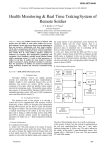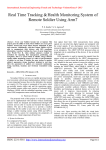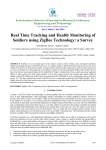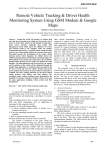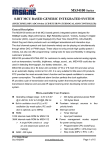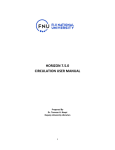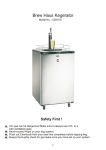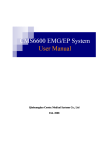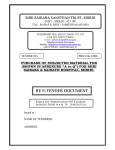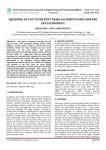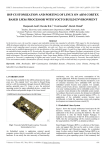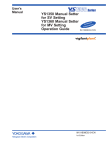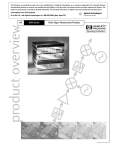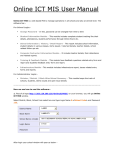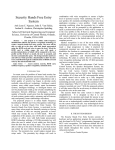Download Real Time Tracking &Health Monitoring System of Remote Soldier
Transcript
P. S. Kurhe et al, / (IJCSIT) International Journal of Computer Science and Information Technologies, Vol. 5 (3) , 2014, 4325-4330 Real Time Tracking & Health Monitoring System of Remote Soldier P. S. Kurhe , K. V. Karad , A. S. Chavan Department of Electronics and Telecommunication, SRES’ College of Engineering, Kopargaon. University of Pune, (M.S.) India. Abstract— Every year Soldiers become lost or injured. This project gives the ability to track where Soldiers are at any given moment. Search and rescue efforts become minimized in time and resources. Additionally, with alert feature Soldiers will be able to communicate their distress with GPS coordinate information. Location tracking has been of great importance since World War II, when military planners realized its usefulness for targeting, fleet management, positioning, and navigation. I have designed a reliable, energy efficient remote soldier monitoring system. It is able to send parameters of soldier in real time. It enables the army station to monitor soldier’s parameters (temp, heartbeat, location) in real time. Here the parameters of soldiers are measured continuously (temp, heartbeat, location) and wirelessly transmitted using GSM. Keywords— ARM, GSM, GPS, Sensors, LCD. I. INTRODUCTION Nowadays Defence services are rapidly growing towards new innovation with advance implementation. Soldier’s health is more important because they are the defenders who protect our country [1].The system is composed of two parts, which are portable remote soldier unit and the monitoring centre. The portable remote soldier unit consists of Advanced RISC Machines (ARM) with the embedded operating system, GPS and a GSM, temperature sensor and heart bit arte sensor [1]. II. A COMPLETE SYSTEM The proposed work of this project is to develop a system that can be supplemented with real-time wireless monitoring systems which are designed and implemented through GPS network and are able to record and transmit bio-signals of soldiers. The aim of this project is to provide a medical monitoring for the soldier at any time and any place and to design a soldier tracking system using GSM and GPS to provide wireless system for monitoring the parameters of soldier are as – Body temperature & Blood pressure. A. System Architecture It is composed of two parts 1) Soldier unit: This unit consists of two types of sensors such as temperature sensor, pulse rate sensor. These sensors are used to measure the signals from the human body such as heat signal, heart bit. After measurement, these analog www.ijcsit.com signals are converted into digital signals and compared with the actual signals. If any discrepancy occurs between the measured signals and the actual signals, then it is considered as an emergency. The ARM 7 LPC2148 processor plays an important role in controlling all the devices. It has an inbuilt A\D convertor. GSM transmitter is used to transmit the signals from the sensors which are controlled by the ARM7 microprocessor. GPS system is used to locate the position of the soldier. It is very helpful for the army station to rescue the soldier as soon as the emergency signal is received. The ARM7 family includes the ARM7TDMI, ARM7TDMI-S, ARM720T, and ARM7EJ-S processors. The ARM7TDMI core is the industry’s most widely used 32-bit embedded RISC microprocessor solution. Optimized for cost and power-sensitive applications, the ARM7TDM solution provides the low power consumption, small size, and high performance needed in portable, embedded applications [1]. The ARM7TDMI-S core is the synthesizable version of the ARM7TDMI core, available in both VERILOG and VHDL, ready for compilation into processes supported by in-house or commercially available synthesis libraries. Optimized for flexibility and featuring an identical feature set to the hard macro cell, it improves time-to-market by reducing development time while allowing for increased design flexibility, and enabling >>98% fault coverage. The ARM720T hard macro cell contains the ARM7TDMI core, 8kb unified cache, and a Memory Management Unit (MMU) that allows the use of protected execution spaces and virtual memory. This macro cell is compatible with leading operating systems including Windows CE, Linux, palm OS, and SYMBIAN OS [1]. 2) Army unit: Upon receiving the SMS, the VB s/w sorts the solder’s location based on the GPS co-ordinates also the health status is displayed. In this way the army official’s can keep a track of all their solders. Similarly, Army officer can also send reply to the corresponding soldier through VB screen in terms of SMS. 4325 P. S. Kurhe et al, / (IJCSIT) International Journal of Computer Science and Information Technologies, Vol. 5 (3) , 2014, 4325-4330 B. Block Diagram Description VCC_3.3V R1 HEART BIT SENSOR INSTRUME NTATION AMPLIFIER 10K C5 22pF LCD RESET XTAL2 Y1 12MHZ C6 C7 XTAL1 0.1uF 22pF XTAL1 XTAL2RESET TEMP. SENSOR ARM LPC 2148 2x2 KEY BOARDS RS 232 64636261605958575655545352515049 1 2 3 4 5 6 7 8 9 10 11 12 13 14 15 16 GSM MODULE GPS ANTENNA VCC_3.3V GND VCC 5V GPS RECEIVE R R1 LCD CONN 10 OHM VCC 5V 3 2 1 P1.31 P1.26 VDD VSS P0.2 VCC 5V PULSE RATE LPC2148 VVSS T VSSAP1.29 P1.30 P1.27 VREF XTAL1 P0.20/SSEL1 OSI1 LCDRS 1 48 P1.20 47 LCDEN 2 P0.21/AD1.6 P0.17 3 P0.22/AD1.7 46 P0.16/EINT0 4 RTCX1 45 P0.15/EINT2/AD1.5 5 P1.19 44 P1.21 43 VCC_3.3V VCC_3.3V 6 RTCX2 VDD 42 GND GND 7 VSS VSS 41 8 VDDA P0.14/EINT1/SDA1 LD4 9 P1.18 40 P1.22 LD5 10 P0.25/AD0.4 39 P0.13/AD1.4 EMER1 LD6 11 P0.26/AD0.5 38 P0.12/AD1.3 EMER2 12 P0.27/AD0.0 37 P1.17 P0.11/SCL1 EMER3 LD7 13 36 P1.23 P0.28/AD0.1 EMER4 14 35 P0.10/AD1.2 15 P0.29/AD0.2 34 P0.5/MISO0/AD0.7 16 P0.30/AD0.3 33 P1.16 P1.25/EXTIN0 P0.8/TXD1 .4/AD0.6 XD0 P0.1/RXD0 EMERGENCY KEYBOARD 1 2 3 4 5 P1.24 17181920212223242526272829303132 VCC_3.3V TXD0 RXD0 GND GND 5V 10uF + U5 1 + VCC 5V 2 10uF 3 2 1 3 4 + 10uF BODY TEMP GSM MODULE PC 5 6 + 10uF 5V 16 C1+ VCC V+ GND C1- 14 TXD PC C2+ 13 RXD PC 15 C2- 12 TXD UC V- 11 RXD UC 7 10 TXD PC RXD UC 8 9 RXD PC TXD UC RS 232 GPS CONN 5V 1 GPS TXD 2 GPS RXD 3 4 Fig. 1 Block Diagram of System The above block diagram shows the overall co-ordination of the system. It shows how the concept is implemented as the real time application.Here there are 2 units under hardware design part:1) Soldier unit: This unit is placed on the soldier. It has mainly 3 parts:Biomedical sensors, Key keypad, GPS + GSM unit 2) Army unit: This unit consists PC with GSM module. PC CONN 5V 1 PC TXD 2 PC RXD 3 4 Fig .2 Basic Circuit diagram of this proposed system C. Temperature Sensor Lm35 The LM35 series are precision integrated-circuit temperature sensors, whose output voltage is linearly proportional to the Celsius (Centigrade) temperature. The LM35 thus has an advantage over linear temperature sensors calibrated in ° Kelvin, as the user is not required to subtract a large constant voltage from its output to obtain convenient Centigrade scaling [8]. The LM35 does not III. DESIGN DESCRIPTION require any external calibration or trimming to provide All the design of proposed system are described in the typical accuracies of ±1⁄4°C at room temperature and following.The figure 2 shows the basic circuit diagram of ±3⁄4°C over a full −55 to +150°C temperature range. Low this proposed system. cost is assured by trimming and calibration at the wafer A. Hardware Description level. The LM35’s low output impedance, linear output, The heart of system is microcontroller which will and precise inherent calibration make interfacing to readout access the data. In our project we will use ‘ARM’ controller. or control circuitry especially easy. It can be used with To measure temperature of soldire there will be a single power supplies, or with plus and minus supplies. As temperature sensor. To convert the output of sensor into it draws only 60 μA from its supply, it has very low selfelectrical form we will use signal conditioning (transducer). heating, less than 0.1°C in still air. The LM35 is rated to As controller operates only on digital data, so this analog operate over a −55° to +150°C temperature range, while the data is to be converted into digital form by using ADC. But LM35C is rated for a −40° to +110°C range [8]. ADC is inbuilt in ARM processor. So the output of the signal conditioner circuit is directly connected to ARM processor. B. ARM 7- LPC 2148 The ARM7EJ-S processor is a synthesizable core that provides all the benefits of the ARM7TDMI – low power consumption, small size, and the thumb instruction. • Operating systems such as Windows CE, Linux, palm OS and SYMBIAN OS. • More than 40 real-time operating systems, Including qnx, Wind River’s vx works. LPC2148 Micro controller: www.ijcsit.com 4326 P. S. Kurhe et al, / (IJCSIT) International Journal of Computer Science and Information Technologies, Vol. 5 (3) , 2014, 4325-4330 D. Heart Beat Sensor Heart beat sensor is designed to give digital output of heat beat when a finger is placed inside it. This digital output can be connected to ARM directly to measure the Beats per Minute (BPM) rate. It works on the principle of light modulation by blood flow through finger at each pulse. Fig . Heart Beat Cavity Measurement System • • send SMS content : coordinate send the message issue Crtl-Z char (0x1A) <CR>: carrier return character (0x0D hex)[4]. Fig:3 GPS Receiver ICLM358is used for Heart Beat Sensor. Its dual low power operational amplifier consists of a super bright red LED and light detector. One will act as amplifiers and another will be used as comparator. LED needs to be super bright as the light must pass through finger and detected at other end. When heart pumps a pulse of blood through blood vessels, finger becomes slightly more opaque so less light reached at the detector. With each heart pulse detector signal varies this variation is converted to electrical pulse [2]. E .GPS Receiver: GPS Module The GPS smart receiver features the 16 channels .Ultra low power GPS architecture. This complete enabled GPS receiver provides high position, velocity and time accuracy performances as well as high sensitivity and tracking capabilities. The hardware interfaces for GPS units are designed to meet NMEA requirements. The GPS receiver provides data in NMEA 0183format with a 1Hz update rate. Generally message received by GPS is in NMEA [National Marine Electronics Association] message format and NMEA protocol which is most commonly used is NMEA0183 protocol. GPS sentences beginning with the following specifications:$GPGGA, $GPGSA, $GPGSV, $GPRMC, and $GPVTG. And sentences also begins with $GPMSS, $GPZDA as shown in [table 1]. 1) The Method of Tracking: The tracking method is based on the process of collecting continuously the coordinate (latitude, longitude) of mobile vehicle that could get from GPS receiver. After getting the coordinate, the mobile vehicle will send it to the supervised center via SMS or GPRS service. The supervised center will receive the coordinate of the mobile vehicle then displays on the screen. The mother board on the mobile vehicle is equipped a GSM modem- GM862 and it is directed by a 32bits microcontroller ARM Cortex M3-LM3S2965. The microcontroller uses serial interface to communicate with GM862 by AT commands and send current position of the vehicle via SMS service by send the sequences commands below: 2) Commands: • AT+CMGF=1<CR> • AT+CMGS=”0937856377”<CR> www.ijcsit.com 3) Specifications: • 16-channels GPS search engine • Ultra low power design (38mA, typical) • Compact size • Built-in low noise, high gain active antenna • Super-cohesive magnetic for installation • High sensitivity (up to -152dBm typ) • Apply to host devices with USB or RS232 4) Applications: • Automotive • Personal/Portable Navigation (PDA) • Geographic Surveying • Sports and Recreation 5) Benefits to User: • Ultra low power consumption • Easy and fast to install • Superior urban canyon performance • Low cost with high performance F. GSM HARDWARE The core of data communication about this system lies in wireless communication control terminals that uses GSM Modules to transfer long-distance data extensively and reliably. It Support instructions of AT commands. SIM300 can be integrated with a wide range of applications. SIM300 is a Tri-band GSM/GPRS engine that works on frequencies EGSM 900 MHz, DCS 1800 MHz and PCS1900 MHz SIM300 provides GPRS multi-slot class 10 capabilities and support the GPRS coding schemes CS-1, CS-2, CS-3 and CS- 4. With a tiny configuration of 40mm x 33mm x 2.85 mm, SIM300 can fit almost all the space requirement in our application. Therefore, the MCU can connect with GSM modules very expediently through serial interfaces. Fig. 4. GSM module 4327 P. S. Kurhe et al, / (IJCSIT) International Journal of Computer Science and Information Technologies, Vol. 5 (3) , 2014, 4325-4330 IV. SOFTWARE DESIGN This includes the coding of ARM 7 processor and coding for downloading of data and for GUI (Graphical User Interface) on server side. For ARM 7 :Embedded c using Keil software. For GUI :VB.Net VI. PARFORMANCE ANALYSIS A. Performance characteristics of system • Range of communication is unlimited due to the use of GPS and GSM communication systems. • As I am using GPS as guider, soldier can be secure to use appropriate guidelines. • Using GSM SMS facility, it is not necessary to transmit any audio signals. These SMS are depending upon the present condition of soldier. • As my system is monitoring parameters regarding with the help of soldiers, it is bit easy to provide a medical services as per requirements. • It is possible to get a resolution less than 100 meters by using super software that being used by foreign countries. • As 3 stage pipelining used by ARM, execution speed of operation bit high. • After each 60 seconds parameters regarding with the health of soldier will be send, so in time we can say a real time operating system. B. Performance Analysis for temperature sensor LM35 TABLE I ANALYSIS OF COLLECTED DATA FOR LM 35 IN SPECIFIC CONDITION Sr. No. 1. 2. 3. 4. 5. Condition of set Temperature in ºC Air Conditioner 25 Normal Room at 33 Open ground at 1:00 pm By using Fire stick kept near to LM35 Freezer bottle with water Readings from Thermometer Output of LM 35 in ºC on LCD 23 24.6 31 32.8 37 36.8 70 73.6 17 17.4 FIG. 5. FLOW CHART V. ADVANTAGES OF SYSTEM • • • • Provides high level safety to human life Suitable for Indian conditions Easy retrieval of data for the cause of incidents. low cost and less complex system for installing and application. www.ijcsit.com Fig.4 Comparison of LM 35 Readings on LCD with Thermometer readings. 4328 P. S. Kurhe et al, / (IJCSIT) International Journal of Computer Science and Information Technologies, Vol. 5 (3) , 2014, 4325-4330 C. Analysis for Pulse rate sensor TABLE II ANALYSIS OF SENSOR DATA FOR DIFFERENT SITUATION Sr. No. Condition for reading Output of sensor in terms of Pulses on LCD INVALID FINGURE PRESS 1. Improper placement 2. Without finger 006 3. At normal 78-88 4. After running of 500 meters 92-120 D. Check functionality of GPS module for different distance TABLE III ANALYSIS OF GPS MODULE FOR DIFFERENT DISTANCE Sr. No. Distance in Meter Initial condition Name of location 2. 3000 Computer Lab. 3. 3000 PG LAB 4. 3000 At Hostel. 1. Kopargaon GPS module Coordinates 1988.339 N 7448.339 E 1988.8390N 7548.0803E 1988.8390 N 7548.0803E 1988.839 N 7548.080 E E. Checking GSM modem with respect to time FIG. 6 PRACTICAL RESULTS VII. CONCLUSIONS From the above designed project I can conclude that ANALYSIS OF GSM MODEM WITH RESPECT TO TIME we are able to transmit the data which is sensed from remote soldire to the server PC by using wireless Sr. No. Parameters Time required transmission technology GPS. It is completely integrated so that it is possible to track anytime from anywhere. It has 15-20 seconds after 1. Initializations real-time capability, emerges in order to strengthen the applying power. relations among people. The accuracy of system is affected NORMAL 9-12 seconds to deliver 2. by some factors such as weather, environment around the Message after sending message mobile soldire unit, GPS receiver, compass sensor and the Emergency 9-12 seconds to deliver variation between True North Direction and Magnetic 3. Message after sending message North Direction, etc. The future works include optimizing Message from 9-12 seconds to deliver the hardware system, choosing a suitable GPS receiver and 4. Army station after sending message compass sensors. Improving the routing algorithm can be improved by neural network. This system has many VII. RESULTS advantages such as large capability, wide areas range, low We continuously scan for various parameters of soldier, operation costs, effective, Strong expandability and Easy to such as latitude, longitude temperature, pulse rate, and use. Upgrading this setup is very easy which makes it open massages. The μC stores all this data in the internal memory. to future a requirement which also makes it more efficient. TABLE V www.ijcsit.com 4329 P. S. Kurhe et al, / (IJCSIT) International Journal of Computer Science and Information Technologies, Vol. 5 (3) , 2014, 4325-4330 VIII . FUTURE ENHANCEMENT There is always chance to improve any system as research & development is an endless process. The following measurements can be done in future: Pulseoximetry and, Galvanic-Skin Resistance Amenia. 1. Soldier Voice Recognition system: IC HM2007 can be used to recognize the voice samples of the soldier, for better security purpose. 2. A Camera can be fitted into the system so as to enable the base station to get a real time view of the battlefield. 3. Automatic Surveillance Robot: A Robot with all the medical features as well as advanced features like ammunition can be build. REFERENCES [1] [2] [3] [4] [5] [6] [7] [8] [9] [10] [11] [12] Ushasree.K, Hameed Pasha, “Protection system for VIP’S with GPRS & Remote monitoring”, International Journal of Computer Trends and Technology- volume2Issue2- 2011. Rubina.A.Shaikh, “Real Time Health Monitoring System Of Remote Patient Using Arm7”, International Journal of Instrumentation, Control and Automation (IJICA) ISSN: 2231-1890, Vol-1 Iss-3,4, 2012. N. Lakshmi Kanthan & V. Babu, “MCEP Based Intelligent Vehicle with Multitask Management”, ISSN (Print): 2278-8948, Volume-1, Issue-2, 2012 . Abid khan, Ravi Mishra, “GPS – GSM Based Tracking System”, International Journal of Engineering Trends and Technology Volume3 Issue2- 2012. Pooja Sathe, “Gprs Based Routing & Tracking Of Mobile Vehicles Using Arm”, International Journal of Engineering Research and Applications (IJERA) ISSN: 2248-9622 www.ijera.com Vol. 2, Issue4, July-August 2012, pp.1088-1090. Ya-lin Miao†, Xiang-lin Miao, Zheng-Zhong Bian , Yong-jie Zhan “Design and Application of Embedded System Based on ARM7 LPC2104 Processor in Telemedicine”, Proceedings of the 2005 IEEE Engineering in Medicine and Biology 27th Annual Conference Shanghai, China, September 1-4, 2005. UM10139 Volume 1: LPC214x User Manual, Rev. 01 -15 August 2005, Philips Semiconductors. LM35 datsheet, National Semiconductor Corporation DS005516, http://www.national.com. LPC2141/42/44/46/48, Rev.5-12 August 2011, http://www.nxp.com. Hui Hu, Lian Fang “Design and Implementation of Vehicle Monitoring System Based on GPS/GSM/GIS” Third International Symposium on Intelligent Information Technology Application ,School of Information Engineering, East China Jiao Tong University, Nanchang, Jiangxi, China in 2009. Pages 278-279. Thuong Le-Tien, Vu Phung-The “Routing and Tracking System for mobile Vehicles in Large Area”, Fifth IEEE International Symposium on Electronic Design, Test & Applications Dept. of Electrical Electronics Engineering, HCM University of Technology, Vietnam in 2010. Umar Farooq, Tanveer ul Haq, Muhammad Amar, Muhammad Usman Asad, Asim Iqbal “GPS-GSM Integration for Enhancing Public Transportation Management Services” Second International Conference on Computer Engineering and Applications, Department of Electrical Engineering University of The Punjab Lahore-54590, in 2010. www.ijcsit.com 4330






